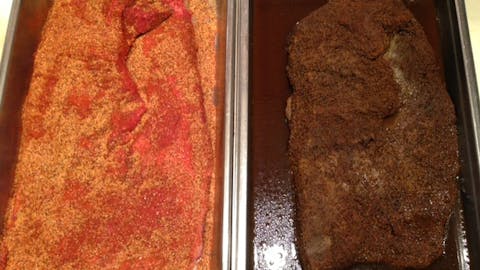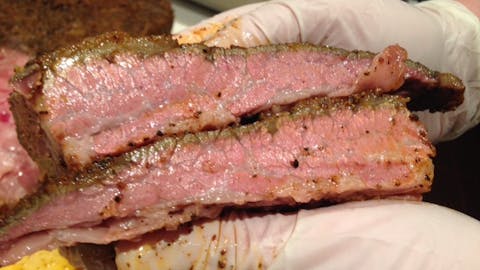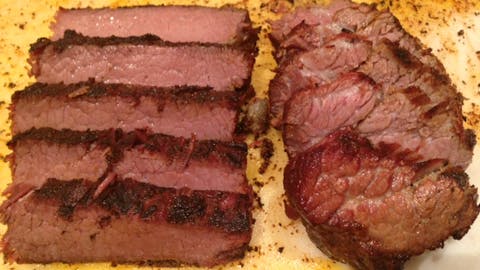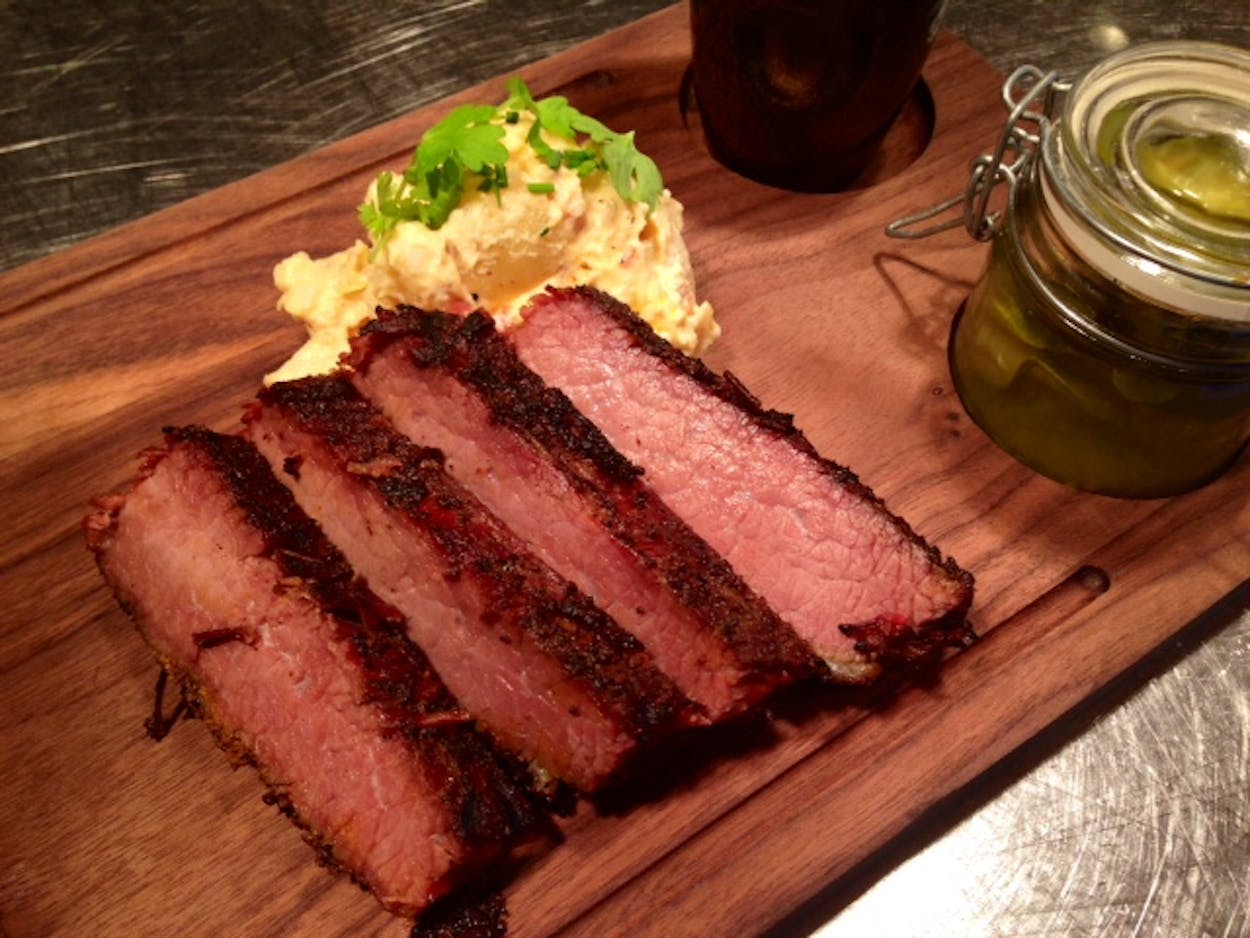Last week we took you to Tioga, Texas, where Warren Clark developed a three-day smoked brisket recipe that is still served at Clark’s Outpost, the restaurant he founded decades ago. His method was borne from his earlier days using a traditional smokehouse in Arkansas, where cooking time was measured in days. One of Clark’s loyal customers was Dallas chef Stephan Pyles, a founding father of Southwestern cuisine. Pyles hasn’t dined at Clark’s in a while, but at Pyles’s newest restaurant, Stampede 66, he and his executive chef Jon Thompson have developed a method for smoking brisket that includes a cook time that surpasses even Clark’s three-day wait. I’m talking nearly one whole week.
Instead of borrowing from the past like Clark did, Pyles looked toward a more modern method. He and Thompson sought a way to get a juicy, tender brisket that would stay fresh through the entire dinner service. You see, Stampede 66 isn’t a barbecue joint. Smoked meats like pork belly and the aforementioned brisket make up about ten percent of the large Texas-inspired menu. You won’t find a big cutting block on view for the customers where meats are sliced to order. Instead, you’ll find a CVap (a humidity and temperature controlled cooking cabinet) and a wood-fired grill behind the line.

The recipe begins with a whole Akaushi brisket from Heartbrand Beef in Flatonia, Texas. On day one, it is trimmed to about 1/8″ of fat or less. There is so much intramuscular fat, even in the flat, of this richly marbled beef that the fat cap isn’t as essential to keeping it juicy. The meat is then heavily rubbed with a spice mixture that’s heavy on the salt. It will cure like this for one full day.

On day two, the cured brisket is removed from the curing pan and placed into a smoker. There isn’t enough room at Stampede 66 for the equipment, so the process moves to Stephan Pyles’ eponymous restaurant just up the street for this portion of the cook. The smoker is fired with hickory, and the temperature is kept very low at 120 degrees. The idea is to cold-smoke the meat, a method most commonly used on items like salmon and cheese, but to avoid actually cooking them. The brisket develops a smoky crust during the twelve hours it spends in here, but the interior will never get above rare.

After the cold-smoke comes the long sleep in the CVap. The smoked brisket is placed into a shallow pan and covered tightly. For the next seventy-two hours (three days!), the meat will bathe in a moist 137 degree heat.
I’ve seen this style of smoked brisket only once before: when a friend let me borrow all six volumes of Modernist Cuisine. Their recipe for smoked brisket called for a 149 degree (150 was too high?) smoke for seven hours, while ensuring 65-percent relative humidity. The final step was to cook sous vide for 72 hours at 145 degrees.

The final step before plating the brisket is grilling an eight ounce portion of the brisket flat directly over a hickory fire. It doesn’t spend long here because this step isn’t to heat up the brisket since it’s fresh out of the CVap. This does two things. It forms a crust over the surface of the beef that has disappeared during its time in the CVap. More importantly, the live fire adds another layer of flavor onto the brisket.

When Stampede first opened, they served both fatty and lean cuts of brisket with the meal, but after too many complaints about the fat, they’ve gone to all lean meat. The fatty point meat is chopped and used in their brisket taco and chopped brisket sandwich. It’s really too bad, because it was in that richly marbled point that you could really experience what the sous vide had accomplished – fat that wasn’t rendered out, but melts readily on the tongue.

Once complete, the brisket is placed on a serving board with house made pickles, potato salad, and barbecue sauce. It’s still got some pinkness to it since all of the color hasn’t yet been cooked out, but it’s very tender. It better be since this brisket costs $20 per serving (including sides), but come for dinner because you can’t get it at lunch.
Biting into a slice, the most prominent flavor is beef. It’s not like roast beef, or a steak, but more like the essence of beef. If it’s a Pecan Lodge brisket you’re expecting, then you’ll be disappointed by the smokiness, but the smoked flavor is certainly present. That final romp over the hickory fire also produces some charred crunchy bits on the surface as well.
I asked Pyles if his numerous visits to Clark’s Outpost influenced his elongated cooking time. “Maybe subliminally, but I don’t think it’s any more than that.” But, they have no need to replicate the methods of a barbecue joint at Stampede 66. You may scoff at this modernist twist on smoking a brisket, but what would Pyles gain by providing something that Dallas already has – good traditional smoked brisket – in a setting and a serving method that doesn’t best complement it? Stampede 66 has found a new way to give us an old favorite, and challenge our ideas about what barbecue is. That’s really what they’ve done with every item on their menu. After all, their tagline is “Modern Texas Cuisine.”
- More About:
- Stephan Pyles








